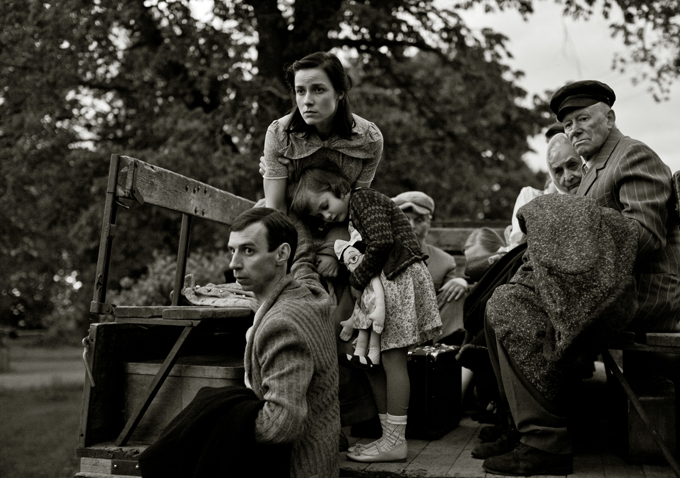 First time features this audacious come once in a blue moon. Young director Martti Helde is still attending the Academy of Music and Theater in his native Estonia, but he found a subject so close to his heart that he realized it into a full-length theatrical feature through years of comprehensive research and preparation. “In The Crosswind” is immediately distinguishable from the ordinary motion picture by the use of painstakingly choreographed tableux vivants – literally, a “living picture” where the actors are motionless, ostensibly frozen in time, as the camera sashays around them. It’s an approach that’s a bit of a double-edged sword for ‘Crosswind’; certain moments will test your patience, but the total effect will leave you awe-struck in the literal sense of the word.
First time features this audacious come once in a blue moon. Young director Martti Helde is still attending the Academy of Music and Theater in his native Estonia, but he found a subject so close to his heart that he realized it into a full-length theatrical feature through years of comprehensive research and preparation. “In The Crosswind” is immediately distinguishable from the ordinary motion picture by the use of painstakingly choreographed tableux vivants – literally, a “living picture” where the actors are motionless, ostensibly frozen in time, as the camera sashays around them. It’s an approach that’s a bit of a double-edged sword for ‘Crosswind’; certain moments will test your patience, but the total effect will leave you awe-struck in the literal sense of the word.
During the Second World War, when Hitler’s Final Solution for the Jewish people was becoming public, Stalin had similar malevolent plans for people living in Estonia, Latvia, and Lithuania. Trains took thousands of innocent people, including women and children separated from husbands, across the Soviet Union and into remote corners of Siberia, in an effort to cleanse the USSR of “anti-Soviet elements.” It’s a vile historical act of ethnic cleansing that doesn’t get the same attention as the Holocaust in most classrooms, yet it affected more than half a million people and untold future generations. Indeed, for many viewers, “In The Crosswind” will be their first encounter with the atrocity, and if for nothing else, the film and its director deserve to be championed for that alone.

But, “In The Crosswind” has more than just an important subject matter going for it. Helde adapts his screenplay from letters written by a young woman named Erna (Laura Peterson), and keeps the heart and soul of his story anchored to this woman’s tale of forced deportation. Along with her young daughter Eliide (Mirt Preegel), Erna is separated from her husband Heldur (Tarmo Song), and the film tracks her entire journey. She would write these letters to her husband (never certain if they would actually reach him), using a distinctly lyrical language, while under the harshest conditions, permeating her own story with a heartbreaking hopefulness and tremendous emotional and intellectual depth.
Due to the film’s idiosyncratic nature with the tableaus, the acting takes a backseat to the cinematography, sound design, and score. Among the 700 other actors used in the film, Peterson and Song stick out in their central roles mostly because of their unique physical attributes; they look like what people from the 1940s looked like, and Helde chose them specifically because of that. Peterson’s eloquent voice-over reciting Erna’s letters adds to the allure of ‘Crosswind,’ but it’s cinematographer Erik Põllumaa, soundman Janne Laine, and composer Pärt Uusberg, who stand right alongside Helde in making ‘Crosswind’ an astonishing sensory experience. Shot in opulent black and white 35mm film, these tableaus – examples include exterior shots of people boarding trains or handing out bread; interior shots of people huddled together listening to the radio – feature rich texture, within the deep contours of history. It is transcendent, ethereal poetry in motion, freezing a dark, overlooked, period in time so that it may embed itself that much deeper in the viewer’s mind. And for the most part it works wonders because of Laine’s sound design and Uusberg’s music. Undistinguishable whispers are used to astoundingly immersive effect, cloaking the overall mood with a sort of mystical atmosphere. The score is a swooning, sensual, sagacious accompaniment to the fluid camera movement, tying Laine’s sound to Põllumaa’s photography with a silky knot.

It is Helde, with his determination to recreate a momentous event of his country’s history with as much realism as possible, who deserves the longest standing ovation. Four years in the making, the complexity of some of the tableaus taking up to six months to prepare, “In The Crosswind” is one of the most courageous and intrinsically detailed feature debuts we’ve ever seen. With its disheartening subject matter, and some of the tableaus struggling to keep our focus, “In The Crosswind” may not be wowing mainstream audiences, but history buffs and cinephiles interested in unique storytelling will feel like they’ve struck gold. Martti Helde has made a grand entrance into arthouse cinema, and we can’t wait to see what he’ll do next. [B+]
Catch up with all our coverage from the 2014 Toronto International Film Festival here.

